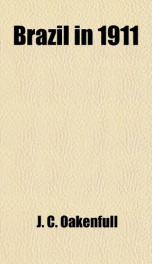brazil in 1911

Purchase of this book includes free trial access to www.million-books.com where you can read more than a million books for free. This is an OCR edition with typos. Excerpt from book: CHAPTER III ANTHROPOLOGY AND ETHNOGRAPHY Accepting the hypothesis of Dr. Lund, the Danish scientist who spent most of his life in Brazil, that this country was the first part of America to be thrust up out of the sea, the theory of the settlement of South America by immigrants from Yucutan, or the Pacific, loses its value. W. Foster (Prehistoric Races, Chicago, 1873), said that all America was peopled by autochthonous wanderers from the Brazilian Highlands. Cerneau, Histoire du Canada (Quebec, 1859) expressed his belief that all the American languages had a common origin. Keane divides the aboriginal Brazilians into four great groups, or families, namely, Cariban, Arawakan, Gesan, and Tupi-Guaranian. The physical features of the country closely connect themselves with the inhabitants, but there is no correspondence between the configuration of the mterior and its political divisions. Both the racial constituents from which the American type was developed appeared in Brazil. The later neolithic Mongolian immigrant, who came by way of Behring Strait, represented advancing peoples probably more numerous than their pleistocene predecessors, and also possessing a much higher development. Survivals of the type would, therefore, seem as if they should be more widely scattered, and distinctly marked, when compared with the ruder, fewer, or less formidable men. There is, however, no doubt about these Brazilian Proto-Mongols. As Burton remarks, this strain demonstrates itself in big, round Calmuck skulls, flat faces, with broad, prominent cheek bones, oblique oriental eyes, rather brown than black. They have also dark, thick eyebrows and thin moustaches fringing large mouths, with pointed teeth, and sparse beards, hardly covering the long, pointed chin. Variation, through vast age...
Info about the book
Author:
Series:
Unknown
ISBN:
1110317859
Rating:
4/5 (3)Your rating:
0/5
Languge:
English
Users who have this book
Users who want this book
What readers are saying
What do you think? Write your own comment on this book!
write a commentif you like brazil in 1911 try:
Other books by this author
Do you want to read a book that interests you? It’s EASY!
Create an account and send a request for reading to other users on the Webpage of the book!

